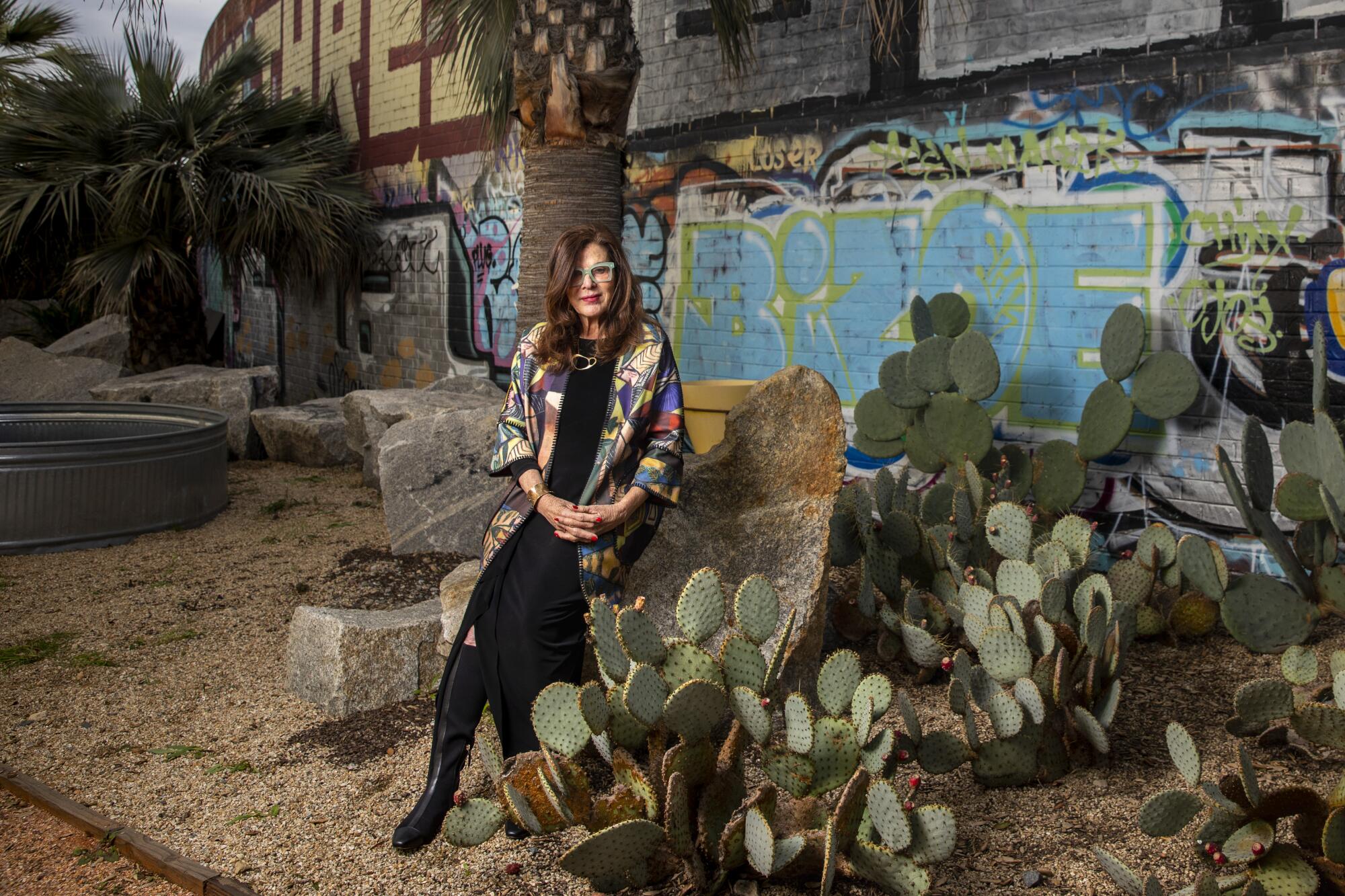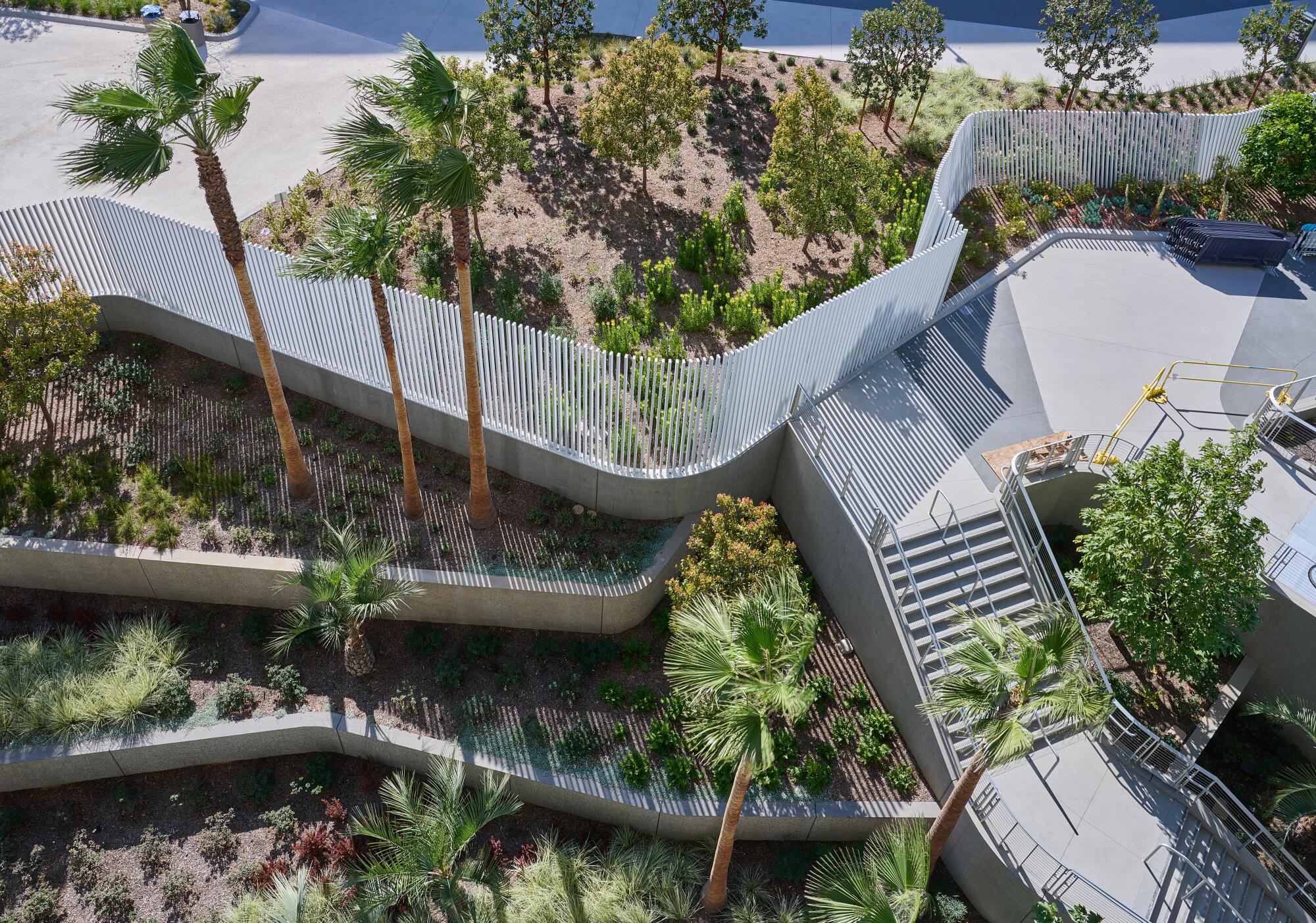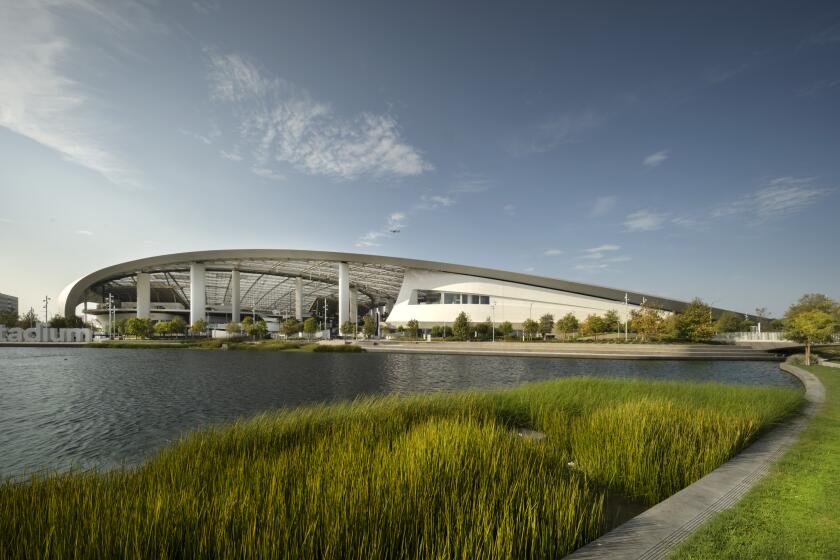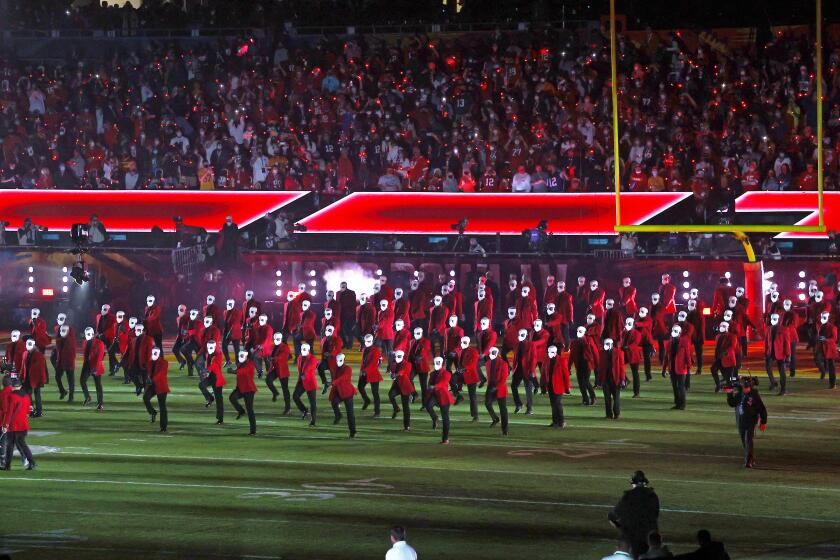
- Share via
Imagine the Los Angeles that might exist if it weren’t encased in a concrete crust: Contours of soft earth rather than rigid asphalt. Aromas that evoke the herbal qualities of sage rather than acrid smog. An urban forest of shady sycamores instead of spindly utility poles.
Over a career that has spanned more than four decades, landscape designer Mia Lehrer has hammered away at those hard surfaces and, in countless places, replaced them with more hospitable landscapes. On a hillside overlooking downtown, for example, at the site of a former oil field that was once studded with oil wells, Vista Hermosa Natural Park now emerges from the dense urban grid like a riot of unsettled landscape.
To the south, in Exposition Park, Lehrer and her team at Studio-MLA, the L.A.-based landscape design firm she founded, ripped out a parking lot on the north side of the Natural History Museum and transformed the site into a 3½-acre garden that functions as a living natural history lab. Stocked with more than 400 plants (70% of them native), its features mimic Southern California’s hydrological phenomena, including a pond and a dry stream. Winding paths of decomposed granite descend into the garden, where loosely arranged vertical slabs of argillite rock — a “living wall” — create pockets for vegetation to grow and animals to inhabit. What was once a car park now feels prehistoric.

Architecture firm HKS designed SoFi Stadium so that even the nosebleed seats deliver a terrific experience. The urbanism around it? Not so much.
Studio-MLA has of late become L.A.’s go-to landscape design firm. It’s worked on landscapes for Dodger Stadium, Banc of California Stadium, the Annenberg Community Beach House and Beverly Gardens Park — in addition to a bevy of commercial, corporate and residential developments. Currently on the drawing boards is landscape work for the under-construction Lucas Museum of Narrative Art. Lehrer’s studio has also transformed schoolyards — historically designed as vast expanses of pitiless asphalt — into greener spaces. And for decades Lehrer has worked, in official and unofficial capacities, to reimagine the concrete-embalmed Los Angeles River. This she has done through informal charettes, in concert with government agencies, and through realized plans that have brought slivers of parkland and stretches of bike lanes to the hard edges of the river. She and her studio were critical members of the team that developed the 2007 Los Angeles River Revitalization Master Plan.
“It’s about projects that create places and spaces that are meaningful to communities,” says Lehrer, sitting over a cup of coffee in her cavernous studio, an old warehouse on the banks of that very river that lies within earshot of the grumble of freight trains.
With the arrival of Super Bowl LVI, one of Studio-MLA’s most prominent projects is now coming into view: its meticulous landscape design for the behemoth $5-billion SoFi Stadium in Inglewood, along with its adjacent Lake Park.
It is a project that Lehrer and her team have been germinating, in one way or another, for 14 years, when reports first emerged that the old Hollywood Park racetrack would shut down and be turned into a mixed-use development. That, at least, was the plan until 2015, when the Inglewood City Council voted to approve a football stadium at the site, which would be shared by the Rams and the Chargers. All of a sudden Studio-MLA found itself designing not just a park and some tidy landscaping around some houses and a shopping center, but an intricate array of park and hardscape elements for a massive new sports and entertainment venue that was nothing like anything Los Angeles or the NFL had laid eyes on.

“There was a sense of ambition for something different,” Lehrer says of the project.
First, though, there was a flash of panic. When Lehrer learned she’d be working on a stadium, she says her first reaction was: “Oh, my God! A football stadium. What does that mean? How do we do this?”
Studio-MLA figured it out — and then some — turning what could have been a blistering expanse of concrete into something that is much more pastoral.
SoFi Stadium is supposed to have a great public art program, but works by Black artists are in limbo. Also missing: the historic sculpture of Swaps, the record-setting thoroughbred from Hollywood Park.
Unlike countless other stadium projects, this one involved the landscape team from the get-go, which means that landscape at SoFi isn’t a sad afterthought but integral to the stadium’s sinuous architecture by the global firm HKS, as well as the venue’s environs.
“We worked with architects from the beginning phases of ideation,” Lehrer says. “That distinguishes it from other stadiums.”
Typically, says Studio-MLA associate principal Kush Parekh, “the perimeter of a stadium is designed to just get people in or out. Here you walk through a park.” The project’s magnitude has been such that Parekh joined Studio-MLA right as the Hollywood Park project was beginning to take off and has lived and breathed it ever since.

SoFi offers terraced gardens and vistas of the San Gabriels and Palos Verdes. Here are 5 places to soak up the best views and design twists.
Under the studio’s purview were 12 acres of public green space surrounding a six-acre lake, as well as myriad landscape elements around the stadium. Mini-botanical gardens — complete with didactics that explain what every plant is and where it comes from — hug the southeastern edge of the lake. Around the stadium, plazas are flecked with jagged fingers of garden lined with benches that provide game-day spectators a place to rest, as well as spots to hang out at times when the stadium is quiet.
Perhaps most ingenious are the open-air “canyons” — terraced levels stitched together by stairways and escalators — that take viewers down to field level and some of the premium seating. Since SoFi sits on the flight path to LAX, the stadium had to be dug into the earth, with a playing field that sits 100 feet below grade. The descent could have been a sullen bulwark of steel and cement. Instead, HKS and Studio-MLA, working in concert, carved vertical canyons around the perimeter of the stadium and filled them with terraced gardens that burst with plantings.

Lehrer says that some of the conceptual design work she did for the Los Angeles River helped inform the design. “If you want to create a park along the river and you wanted to get people down, you’d have to create steps,” she says. “What does that look like? How can you get down comfortably and plant along the way and create a park?”
All of that thinking is on view at SoFi, where three canyons — on the northern, western and eastern edges — function as the most graceful entrance to any stadium I’ve been to.
A stuporstructure? OMA’s first major building in L.A. has seductive moments plus drive-by appeal. So why is Shohei Shigematsu’s design so hard to love?
The plant palette throughout the development draws exclusively from Mediterranean zones around the world: California, South Africa, Chile, Australia and the regions that hug the Mediterranean Sea (southern Europe and northern Africa).
In and around the stadium, the focus is on California, including California sycamores, coast live oaks, blue hesper palms and island snapdragons. Each SoFi canyon is landscaped to reflect a different biogeographic zone from the state. On the sunny north end is a desert garden. On the steeper, shadier canyon on the eastern side, plantings reflect upper and lower montane areas. Toward the west, which is more open and faces Lake Park, as well as the Pacific Ocean in the distance, the vegetation is inspired by low-elevation chaparral and riparian ecosystems.
Woven into this are touches of whimsy. A passenger drop-off point on the eastern side features a traffic island full of Seussian tree aloes surrounded by an arrangement of charcoal-colored slate that resembles the scales of a Mesozoic beast. On the western side, spectators entering through American Airlines Plaza wind their way through a landscape studded with bulbous Australian bottle trees.

And there’s the lake, the centerpiece of Lake Park, which is open to the general public when events like the Super Bowl aren’t happening.
The lake isn’t simply a decorative piece. It takes storm runoff and reclaimed water and filters it through a series of wetland areas, as well as mechanical systems. That water is then used to irrigate the park. (Also working on the design of this feature, among others, were a battery of firms specializing in engineering and hydrology, including Pace Engineering, Fluidity Design Consultants and David Evans and Associates.)
Like any urban lake, its aesthetic qualities provide a respite from the urban landscape that surrounds it. Stand at its southern edge in the late afternoon when the light glows and it’s as if the curl of the stadium’s roof is rippling into the water like a wave at low tide.
“The park is at the heart of the development,” says Parekh, noting that if you look at the broader site from overhead, it’s the lake that occupies the center of the property, not the stadium. “The park is the heart.”

Born Mia Guttfreund in San Salvador, Lehrer is the daughter of German Jewish refugees who fled to Latin America around the time of the Nazi purges of Kristallnacht. Neither of her parents had high school degrees, but her father, armed with a vigorous work ethic and can-do spirit, found success in the export business. She credits her curiosity and her appreciation for nature — he was a hummingbird fanatic — to him.
Vista Hermosa is an L.A. park like no other
In the late 1970s, as El Salvador slipped toward civil war, Lehrer’s father urged her to leave the country and complete her undergraduate studies in the U.S. She went to Tufts University outside of Boston, where she had every intention of becoming an urban planner. But one day, while attending a lecture at the Harvard Graduate School of Design, she stumbled into an exhibition of Frederick Law Olmsted’s landscape drawings for New York City’s Central Park and was bowled over. “One drawing was the vegetation, another was the waterways, another was the special features, the grading,” she remembers. “It was beautiful.”
She located a staffer affiliated with the design school and asked, “What do I have to do to do that?”
The answer: landscape architecture.

As soon as she completed her degree at Tufts, she applied to the landscape design program at Harvard, where she studied under figures such as Peter Walker (who later designed the landscape for the National September 11 Memorial and Museum) and marinated in the work of thinkers such as Ian McHarg, author of the influential 1969 book “Design With Nature,” a work that helped bring a critical environmental consciousness to urban design.
Lehrer also became acquainted with important Harvard alumnae, such as Canadian landscape architect Cornelia Hahn Oberlander, who became an important sounding board and mentor. Oberlander, who died last summer at the age of 99, was a woman in a field that, for much of the 20th century, was dominated by men. “She came down to visit my projects,” Lehrer says. “It was so important to me because she was so supportive. I would tell her my trials and tribulations.”
At Harvard, Lehrer also met her husband: architect Michael Lehrer, who also runs a namesake practice in Los Angeles. The spiffy design of Studio-MLA’s capacious warehouse offices can be credited to his team.

After graduation, the couple relocated to Southern California — first, to Orange County, then to Los Angeles, where Michael was from. For years, Mia ran a private studio out of her home focused on residential landscape design, working on projects for a who’s who of entertainment industry figures such as Robert Zemeckis, Jamie Lee Curtis, Dustin Hoffman and producer Joel Silver.
But by the late 1980s, a number of factors were pushing her toward the public sphere. This included her ongoing interest in environmental issues — something that could be a difficult sell for private clients intent on creating fantasy worlds. And there was activist work around her children’s elementary school in Los Feliz, where she helped plant trees and green courtyard areas. This was followed by tree planting projects around the neighborhood — efforts that connected her with Andy Lipkis, the founder of TreePeople.
Advocates say the $15-an-hour contract is far from satisfactory for those working during one of the year’s biggest money-making televised sports events.
Lipkis is a “cross pollinator,” she says. “He would curate conversations that involved people from the county and the Metropolitan Water District and the Department of Water and Power,” as well as engineers, activists and people from the film industry. It was through these conversations that she became friends with poet and Friends of the Los Angeles River founder Lewis MacAdams, who was an abiding force in reimagining the L.A. River.
The sessions led her to make the public realm a professional focus rather than a sidebar to her private work. “The power that I had was in communicating design and design ideas and helping people own the decision-making process,” she says. This kicked off decades of activity for Lehrer around the river, including her work on the 2007 master plan.
During this period, Lehrer went from working in her informal home office to establishing a professional studio, Mia Lehrer Associates, in 1995. That has since evolved into Studio-MLA. Her firm now employs 45-plus people and includes a small satellite office in San Francisco.

After we converse on a Friday morning, Lehrer unlocks the gate to the back of her studio and leads me and Times photographer Jay L. Clendenin onto the railroad tracks that sit between her studio and the river. She scans the landscape before us for old railroad spikes and rail clips that she will deposit in the sliver of a graffiti-saturated garden that abuts her studio. She points out the ways in which the river’s embankments could be reimagined: with garden-covered steps or with a cantilever boardwalk.
At a point at which many designers would perhaps be resting on their laurels, Lehrer is still thinking energetically about all of the other sites where she would like to intervene — including the L.A. River.
Before Stan Kroenke and SoFi Stadium, numerous groups tried to lure the NFL back to Los Angeles by proposing spiffy stadiums. Here’s how some looked.
In 2015, Frank Gehry began working on a follow-up master plan with the L.A. River Revitalization Corp., a nonprofit group that was created to manage renewal efforts. It was rather surprising news given that Gehry is neither a landscape architect, nor does he have extensive experience with hydrology projects.
I ask Lehrer, who is not involved in the current planning, how she feels about it. She demurs on commenting about Gehry’s plan directly but says she is proud of the work she has done to make this moment possible.
“Plans lead to plans,” she says. “That [2007] plan allowed planting guidelines to get adopted. It identified sites that were publicly owned that could be turned into parks and areas where you needed bridges to connect communities.”
“Our documents made it a reality,” she says. “We have a river. We need to fix it.”
Gehry or no Gehry, Mia Lehrer is determined to keep chipping away at the concrete.



















